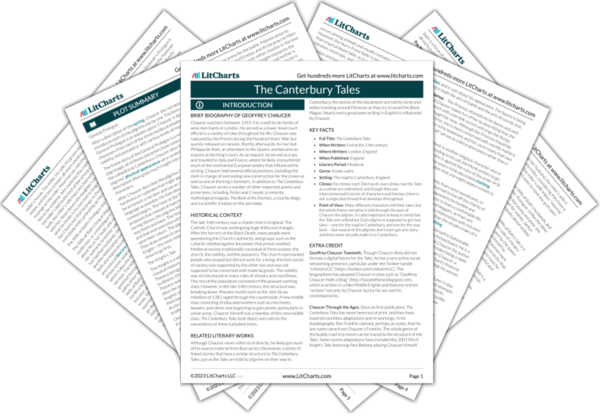The frame narrative of the Tales itself is religious: everybody is on pilgrimage to Canterbury. But these are not necessarily the most pious pilgrims in the world: for many of the travelers, that the pilgrimage is a tourist expedition rather than a devout religious quest.
The Catholic Church was an enormously powerful force in medieval society, and extremely wealthy. The elaborate, ornate, gilded cathedrals built to enshrine saints’ relics were very costly, and the Church also collected regular tithes from its members. By the late fourteenth century, people had begun to become deeply suspicious of the Church’s ostentatious wealth. After the Black Death, which wiped out at least a third of the population, many people no longer trusted the Church’s authority. Church official were often seen as corrupt, bribing and coercing people to obtain money for the church under false pretences. Since members of the church were not allowed to work for a living, they had to gain money by other means. Friars took a vow of poverty and roamed the countryside, relying on charitable donations for their livelihood. Summoners brought sinners to the church court for punishment. People bought indulgences from pardoners to purchase forgiveness for their sins.
The religious figures in The Canterbury Tales highlight many of the problems corrupting the medieval Church. The Monk, who is supposed to worship in confinement, likes to hunt. Chaucer’s Friar is portrayed as a greedy hypocrite. He tells a tale about a summoner who bribes an old innocent widow. The Summoner, in retaliation, skewers friars in his tale, satirizing their long-windedness and their hypocrisy. The Pardoner openly admits to selling false relics to parishioners. Though the Prioress supposedly wears a rosary in devotion to Christ, her ornate token seems much more like a flashy piece of jewelry than a sacred religious object.
Church Corruption ThemeTracker

Church Corruption Quotes in The Canterbury Tales
Whan that Aprill with his shoures soote
The droghte of March hath perced to the roote,
And bathed every veyne in swich licour
Of which vertu engendered is the flour;
...
Thanne longen folk to goon pilgrimages
...
And specially from every shires ende
OF Engelond to Caunterbury they wende,
The hooly blissful martir for to seke,
That hem hath holpen whan that they they were seeke.
Ful weel she soong the service dyvyne
Entuned in hir nose ful seemly,
And Frenssh she spak ful faire and fetisly,
After the scole of Stratford atte Bowe,
For Frenssh of Parys was to hir unknowe.












